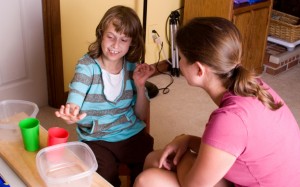Physical Therapy & Cerebral Palsy
Physical therapy is an important part of rehabilitation for many different conditions, but it is especially important in the treatment of cerebral palsy. In fact, it is probably one of the most important aspects of treatment for this condition.
Physical therapy for cerebral palsy aims to improve flexibility, strength and mobility, and can help children with CP improve functions such as standing, walking, climbing stairs, reaching, or operating a wheelchair.
The Role of Physical Therapy

Physical Therapy & Cerebral Palsy
Physical therapy involves working with cerebral palsy patients in order to train, strengthen and control their large muscles (arms, legs, and abdomen). The ultimate goal is to help the child maximize his or her functional control or to increase their gross motor function.
The goals of physical therapy include (but are not limited to) the following:
- Development of coordination
- Building strength
- Improvement in the child’s balance, posture and gait
- Maintaining flexibility
- Optimization of physical functioning levels
- Reduction of pain and discomfort
- Maximizing independence
- Decreasing the potential for contractures and deformity of the joints
A physical therapy regimen may involve activities such as:
- Stretching — Children with cerebral palsy often have increased muscle tone. Stretching will keep the child’s muscles lose and allow for increased mobility.
- Strengthening — Strengthening the muscles is a core principal of physical therapy. The stronger a cerebral palsy patient’s muscles are, the more stress and fatigue they are able to handle.
- Positioning — Positioning is one of the more-complex aspects of physical therapy. Positioning is carried out through the utilization of braces, immobilizers, wheelchair pads and various other techniques.
Physical therapy for a cerebral palsy child will change over time. Physical therapists will teach exercises and methods to a child’s parents that may be adapted for different limitations in the future. The involvement of a parent in their child’s physical therapy is very important for the development of the child.
Types of Physical Therapy
- Aquatic Therapy
- Sports
- Dance Therapy
- Exercise
- Lokomat Machine
- Yoga Therapy
- Therapeutic Riding (Hippotherapy)
Benefits of a Physical Therapist
Anyone who has cerebral palsy can benefit tremendously from physical therapy—especially young children. Physical therapy can help those with cerebral palsy increase strength and improve their capacity for movement in order to function at their highest levels throughout all of life’s stages. A physical therapist will also help develop equipment to aid the patient in physical therapy, and can advise you of what (if any) assistive devices may help your child extend his or her mobility.
There are several stages of physical therapy that will take place, depending on the personal and unique needs of an individual. The physical therapist will coordinate a treatment plan with other healthcare professionals that may include speech & language pathologists and/or occupational therapists in order to ensure the program meets all aspects of the individual’s needs.
Some people may confuse physical therapy with occupational therapy, which is a separate entity all together (although there is some degree of overlap). Occupational therapists will focus more on very fine motor skills, such as movements with the muscles in the hands and face, rather than the larger scale movements a physical therapist may focus on.
Finding a Good Physical Therapist
It’s important for those who have cerebral palsy to work with a therapist who is experienced in treating children with CP. When searching for a physical therapist, it’s recommended that you:
- Make an appointment at a physical therapy clinic and inquire about the experience of the therapists in treating people who have cerebral palsy.
- Make sure to describe the symptoms in great detail during the first visit. It’s also important to identify any specific actions that make the symptoms better or worse.
It’s important to remember there are benefits to physical therapy not only for the children but also for the caregivers. When seeking a physical therapist, we’d like to reiterate that the most important preliminary goal is to find someone who specializes in the treatment of children with cerebral palsy.
You as a parent play an important role in this type of therapy as well. The amount of time the patient spends on therapy at home will directly correlate with how successful the therapy is.
